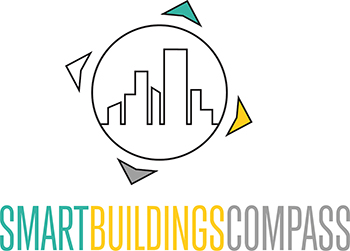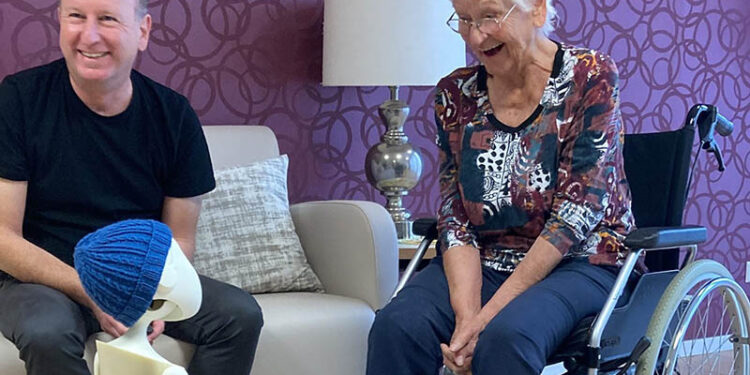There is technology that just works – and there is technology that touches. The empathy robot
In Europe, humanoid robots such as Navel have so far been the exception rather than the rule in the care sector. The projects have remained stuck at the pilot stage – not because of a lack of ideas. It is often due to technological skepticism and the fear that the cold technology would undermine human contact. Current legislation also makes robotic solutions in care difficult.
However, a key driver of progress in humanoid robots is the integration of artificial intelligence. This technology allows robots to recognize and respond to human emotions, gestures, and speech, which in turn enables human-like interactions. And practice shows: Well-applied social robotics complements relationships and activates them.
That’s why we spoke to Navel developer Claude Toussaint about what makes Navel an empathic robot and how it is already being used today.

Navel Robotics GmbH is a start-up from Munich that specializes in the development of empathic, social robots. The company was founded in 2017 and aims to make artificial intelligence and robotics intuitively accessible to everyone – especially for applications in the field of social work.
Our interview partner: Founder & CEO Claude Toussaint.
Against loneliness and cognitive decline
“Navel can talk to its counterpart just like you would talk to another person,” explains developer Claude Toussaint. The decisive factor for him is not only what is said, but also how it is said: Eye contact, tone of voice, pauses, small gestures. “We don’t just exchange words, we read moods – and that’s exactly what Navel can do.”
In care facilities that work with Navel, teams report that after a short time there is more talking and more laughter. Those who had previously withdrawn dare to utter the first sentence again. And this first sentence often turns into a conversation with each other. Communication is not an end in itself here: it trains cognitive and emotional skills – especially where dementia and listlessness make everyday life difficult.
Claude Toussaint understands the concern that technology is replacing people and human relationships – but: “Communicating with Navel is simply fun. It motivates people to talk to it. And in doing so, it fires up communication in general,” says the developer.
Of course, human relationships are always better, but they are not so easy to develop. “Studies show that social robots can strengthen communication between people. We often see in care homes that residents live next to each other but are mentally and emotionally lonely. They don’t open up to their room neighbors,” says Toussaint about the benefits. This is exactly where the social robot comes in: “It improves everyday communication with each other.”
Why this is so important: Cognitive and emotional abilities decline with age. Toussaint explains: “Using communication skills trains the brain. After just six weeks of use, the cognitive abilities of people with dementia in particular improve significantly. Navel makes nursing home residents want to talk and talk again. Residents always complain that this is tedious and exhausting at first. But that is precisely the training and the powerful effect of Navel: you have to concentrate and make an effort.”
This activation even works for people suffering from dementia, and therapists even use Navel for people with severe dementia with whom communication is no longer possible. Care home managers state that the atmosphere has improved: People simply talk more, laugh together more – and that’s good for everyone.
Breaking down barriers: Personal, multilingual, close to everyday life
What makes Navel special is his keen sense of everyday life. He addresses people by name, remembers previous conversations and picks up where you last left off. He chats about cooking or traveling, tells a joke, recites a poem – and when things get serious, he remains cautious. Navel knows his way around many subjects: From history and art to technology, and he keeps the conversation going. This individual approach is a door opener: a desire to talk instead of withdrawal, smiles instead of emptiness. Toussaint: “If someone likes to discuss literature from the last century, they will find a conversation partner in Navel where there is no one else.”
It also provides support where there are language barriers: For example, when care staff and care home residents do not speak German as their mother tongue. “By the end of the year, Navel will be able to translate between residents and care staff from abroad. Many people find it easier to communicate when people speak in their native language, and dementia also causes people to revert to their mother tongue. It therefore also supports the activation of residents with roots abroad.”
On average, 20% of care home residents are “shockingly in love” with the cute little guy, while another fifth do not want to communicate with technology. “The remaining 60% first watch from a distance how others have fun with Navel. And then they want to talk to him,” says Toussaint.
Humanoid robots such as Navel are the exception rather than the rule in the care sector in Europe. However, a key driver is the integration of artificial intelligence and enabling human-like interaction. Credit: Navel Robotics GmbH
Around 1/5 of the residents are shockingly in love with Navel, around 1/5 reject technology. The rest first look at communication with Navel from a distance and then want to interact with it. Credit: Navel Robotics GmbH
Navel uses Large Language Models for its language understanding and dialogic presence. Credit: Navel Robotics GmbH
Empathy as a design principle
Behind the ease with which Navel communicates is hard development work. He uses so-called large language models for his understanding of language and his dialogical presence. Its sensors continuously record the context and social signals of its counterpart: facial expressions and gestures, direction of gaze, emotions. This information is used to create a response that is appropriate to the situation: Friendly, patient, attentive. “We have developed a very special technical solution that no other robot in the world has. Navel can display various emotions, but also make eye contact,” explains Toussaint.
The design is deliberately reminiscent of a likeable Walt Disney animation character: low-threshold and cute, inviting contact. It’s not about strength and endurance, as with the use of robotics in industry. It’s about patience and kindness, endless attention and unconditional positive affection – 24/7.
Today, Navel is still a pre-series model that is only used under the supervision of nursing and care staff. However, it is clear that not only a product but also a field of application is being developed to maturity. Namely the support and relief of care staff in so-called cognitive and emotional care activities.
After all, caring is an intensive emotional task: Depending on the situation, one’s own feelings need to be regulated or shown (kindness, gentleness). At the same time, it is important to recognize and respond to the feelings of those affected. This requires a new social orientation on the part of the carer with every interaction and a permanently high standard. According to the BARMER Caregiver Report 2023, more than one in two caregivers state that they are often or always emotionally exhausted. This is where Navel can provide support and relief.
In future, it will also be possible to run errands and support documentation in the wards.
“Waiting is not an option”: A look at the framework conditions
What does Claude Toussaint want from politicians? “Five or ten years ago, it was hard to imagine that technology could also provide effective support in social work – the laws of the time were designed accordingly. Today, they slow down innovation and prevent the use of technology that is demonstrably good for people,” criticizes Toussaint.
This is a shame for those affected, frustrating for start-ups and ultimately a disadvantage for the location: “If we wait, solutions like ours will eventually come cheaper from China. Instead, we should now adapt the legal framework so that AI and robotics are used responsibly, in compliance with data protection regulations and in line with our values. These systems are powerful, which is why their use belongs in our hands. And not in the unsupervised hands of corporations elsewhere. Waiting is certainly not an option.”
Find out more about Navel: https://navelrobotics.com
Author: Anja Herberth
Chefredakteurin
















